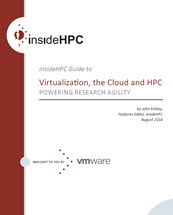
Over the past several years, Virtualization has made major inroads into enterprise IT infrastructures. And now it is moving into the realm of high performance computing (HPC), especially for such compute intensive applications as electronic design automation (EDA), life sciences, financial services and digital media entertainment. It took a while. Virtualization dates back to the 1960s when some of the earliest mainframes claimed center stage in the “glass house” data centers of the day. Back then the term meant dividing up mainframe’s resources to handle various applications. However, it wasn’t until the late 1990s when a group of Stanford University researchers figured out how to virtualize the x86 instruction set that virtualization was able to move from the mainframe to the mainstream. Those same researchers went on to form VMware and release the first virtualization product for the x86 ISA in 1999.
What is Virtualization?
Hardware virtualization refers to the creation of a number of self-contained virtual servers that are resident on the physical server, or host machine. Virtualization allows multiple applications to be run on the same machine while providing security and fault isolation. Typically an administrator decides how much of each resource — CPU, memory, networking - to allocate to the virtual machine (VM), while assigning priorities to different classes of users. The virtual infrastructure dynamically enforces these policies to ensure that each VM gets its fair share of resources. Another key attribute of x86 virtualization important to HPC is hardware abstraction. With virtualization, there is no need to retool the IT infrastructure’s OS and drivers every time new hardware is added to a cluster. The OS always sees the same virtual hardware regardless of the underlying physical hardware type. Hardware abstraction provides the ease of use and agility that physical (bare metal) clusters lack. As virtualization became more prevalent, both Intel and AMD have continued to add more hardware support for the technology, including CPU, memory and I/O virtualization. These hardware advancements, coupled with increasingly sophisticated virtualization software, have resulted in improved performance for a wide variety of workloads, including HPC-based applications. Server virtualization used in the enterprise data center for IT infrastructure workloads has yielded a number of benefits.
All information that you supply is protected by our privacy policy. By submitting your information you agree to our Terms of Use.
* All fields required.




